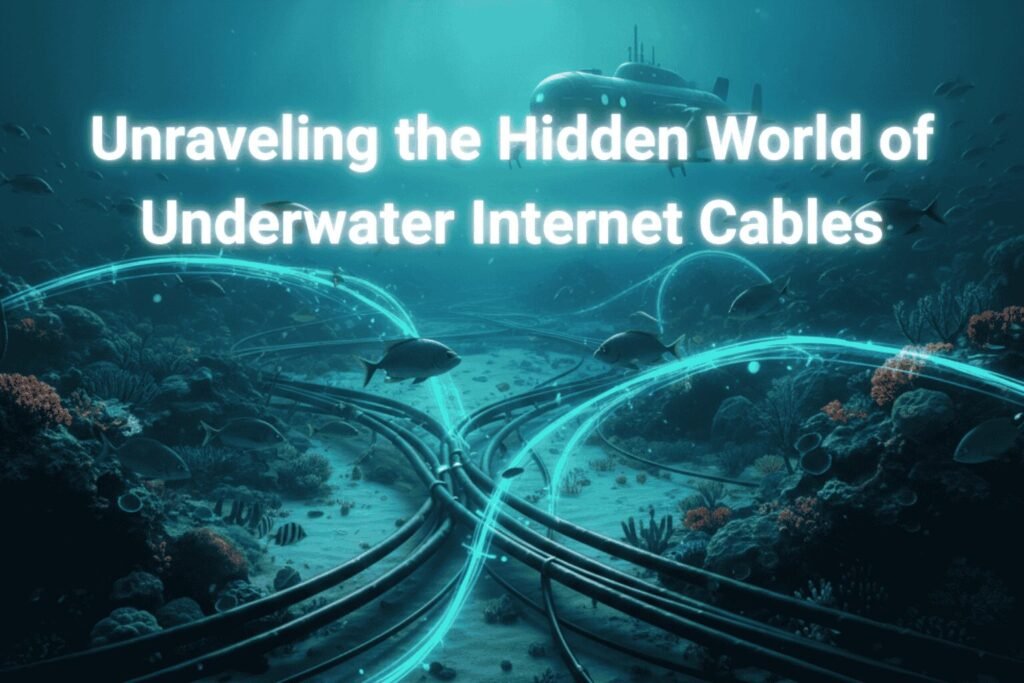
Table of Contents
You are reading these words, most likely on a device connected wirelessly to the world. Perhaps you’re on a laptop over Wi-Fi or a phone using a cellular signal. This experience feels ephemeral, magic—a seamless dance of data through the air. We call it “the cloud,” a name that reinforces the illusion of a weightless, ethereal digital realm.
But this is a myth.
The true backbone of our global internet, the engine of the digital age, is overwhelmingly physical, tangible, and monumental. It lies not in the air, but in the deep, dark silence of the ocean floor. A sprawling network of fibre-optic cables, each no wider than a garden hose, snakes across the world’s seabeds, connecting continents and powering our modern lives. This is the story of that hidden infrastructure—the most critical, and most vulnerable, system you’ve never seen. For a space-based alternative, check out The Role of Satellites in Global Internet Coverag.
By the Numbers: The Staggering Scale of the Submarine Web
To understand the importance of this system, one must first grasp its sheer scale. Over 1.3 million kilometers of these cables crisscross the globe, a length sufficient to wrap around the Earth’s equator more than 30 times. They traverse the deepest trenches and shallowest shelves, linking every continent except Antarctica.
The capacity of these cables is even more mind-boggling. A single pair of optical fibres within a modern cable, such as the Google-funded Dunant cable between the US and France, can transmit in excess of 250 Terabits per second (Tbps). To put that in perspective, that single cable system can support many tens of millions of people streaming 4K video simultaneously. Every second.
This brings us to the most crucial statistic: over 99% of all international data and voice communications are carried by these submarine cables. The satellites orbiting Earth, often mistakenly credited as the primary conduit, handle less than 1%. They are vital for broadcasting, remote connectivity, and backup, but they are fundamentally limited by physics: higher latency (the delay in signal transmission) and drastically lower bandwidth. When you send an email from Toronto to Tokyo, join a Zoom call with colleagues in London from Sydney, or watch a Netflix show hosted in Brazil, your data is almost certainly traveling as pulses of light through a cable on the ocean floor.
Anatomy of a Digital Artery: More Than Just a Wire
A common misconception is that these deep-sea cables are thick, robust industrial power lines. In reality, the part that does the work—the optical fibre—is incredibly thin, as fine as a human hair. The immense thickness of the cable, which can reach up to the size of a large soda can in shallow waters, is all about protection.
A submarine cable is a marvel of materials engineering, built to survive immense pressure, accidental impacts, and a corrosive environment. Its cross-section tells a story of defensive layers:
- The Core: At the very centre are the optical fibres, strands of ultra-pure glass that carry data as pulses of laser light.
- The Lubrication & Buffering: The fibres are suspended in a thick, viscous compound of petroleum jelly or a similar gel. This acts as a shock absorber and prevents water penetration.
- The Power Source: Wrapped around this core is a thin copper tube or ring of copper wires. This carries a high electrical current (up to 10,000 Volts) to power the optical amplifiers (or repeaters) placed along the cable’s length every 50-100 kilometers. These amplifiers are essential for boosting the light signal, which would otherwise degrade over such vast distances.
- The Armor: The entire assembly is then sheathed in multiple layers of protection. This includes tough polycarbonate, aluminum water barriers, stranded steel wires, and an outer jacket of tar-soaked nylon or polyethylene. In deep-sea environments, where the threats are minimal, the cable is lighter. As it approaches shore, where fishing activity (trawling) and ship anchors pose the greatest risk, the cable is heavily armored, sometimes even buried beneath the seabed.
Laying the Lifeline: A Nautical feat of Engineering
Deploying this infrastructure is a complex, painstaking, and extraordinarily expensive process that can take years from planning to completion. It involves a fleet of specialized ships that are more like floating factories.
The process begins with intense planning. Routes are meticulously charted by marine surveyors using sonar and submersible drones to map the seabed. Engineers seek the safest path, avoiding coral reefs, seismic fault lines, shipwrecks, fishing grounds, and other existing cables.
The cable itself is stored in massive, circular tanks within the hull of the cable-lay vessel. As the ship slowly moves along the predetermined route, the cable is fed off the stern through a sophisticated system of tensioners and plows. In deep water, the cable is simply laid directly onto the stable seabed. However, in shallow coastal areas (less than 1,000 meters deep), a seaplow is often used to trench the seabed and bury the cable for its protection. This is a slow and precise operation; a modern ship might lay only 100-200 kilometers of cable per day.
The entire operation is monitored 24/7 from a control room on the ship, watching for fluctuations in tension, ensuring the cable is feeding correctly, and navigating the exact course. It’s a ballet of engineering, oceanography, and sheer nerve.
The New Owners of the Internet: From Telecom Consortia to Tech Titans
For over a century, the submarine cable business was the exclusive domain of consortiums of telecom giants—companies like AT&T, British Telecom, Orange, and NTT. These companies would form a club, share the immense cost (often hundreds of millions to over a billion dollars per cable), and each get a share of the capacity for their customers.
The 21st century has witnessed a seismic shift in this model. The explosion of data demanded by their services—cloud computing, video streaming, social media, and AI—has pushed tech giants like Google, Meta (Facebook), Microsoft, and Amazon to become the primary investors and owners of new cable infrastructure.
This is not a side project; it is a core strategic imperative. Google alone has invested in over 20 cable systems worldwide, including private cables like Curie (US to Chile) and Dunant (US to France). Meta’s monumental 2Africa cable, once completed, will be one of the largest ever built, circumnavigating the African continent and connecting Europe and the Middle East.
This shift grants these companies unprecedented control over the global internet’s plumbing. It ensures they have the cheap, abundant, and reliable bandwidth they need to grow, but it also centralizes immense infrastructural power in the hands of a few private entities, raising new questions about the future of digital sovereignty and competition.
The Vulnerabilities: Where the Internet is Most Fragile
For all its engineering brilliance, the submarine network is fragile. It exists in a hostile world, and its outages can cripple entire regions, revealing just how dependent we are on these hidden threads.
The most common cause of disruption, accounting for over two-thirds of all faults, is human activity. Fishing trawlers dragging anchors and nets along the seabed can easily snag and break a cable. In 2008, a series of cable cuts in the Mediterranean Sea, suspected to be from ship anchors, dramatically slowed internet connectivity across the Middle East and India, highlighting the cascading effects of a single break.
Natural disasters also pose a significant threat. Earthquakes and underwater landslides can sever multiple cables at once. A prime example is the 2006 Hengchun earthquake off the coast of Taiwan, which broke eight cables and disrupted communications across vast parts of Asia for weeks.
Finally, there is the looming threat of intentional sabotage and geopolitical conflict. The world’s digital infrastructure has become a new domain of geopolitical competition. The locations where many cables converge—such as the Luzon Strait near Taiwan, the Red Sea, and the English Channel—are considered critical chokepoints. The potential for state-level actors to target cables for espionage or to inflict economic damage is a major concern for military and intelligence agencies worldwide. Recent incidents of cable damage in the Red Sea have only amplified these fears.
Security, Spying, and Sovereignty
This vulnerability extends beyond physical damage to the realm of espionage. The same cables that carry our cat videos and emails also carry financial transactions, government communications, and state secrets. Programs like TEMPORA, run by the UK’s GCHQ, have been revealed to involve the tapping of submarine cables to mass-collect data.
This practice raises profound questions about data sovereignty—the concept of which country’s laws apply to data. The physical path of a cable matters immensely. Data traveling from Canada to Germany via the UK might become subject to British surveillance laws simply because it transits through a “point of landing” on British soil. This has forced companies and governments to rethink data routing, sometimes choosing longer, more expensive paths to avoid jurisdictions with aggressive surveillance regimes.
The shore station, where the cable emerges from the ocean and connects to the terrestrial network, is therefore a critically sensitive asset, often housed in anonymous, heavily fortified buildings designed to withstand everything from storms to break-in attempts.
The Future of the Deep-Sea Network
The demand for this subsea capacity shows no sign of slowing; it is accelerating. The next great driver is the Artificial Intelligence revolution. The training and operation of large-language models (LLMs) like ChatGPT require the transfer of unimaginably vast datasets between global data centres. This AI boom is directly fueling a new cable boom, with tech companies racing to build ever-faster, higher-capacity links.
This demand is also driving innovation in routes and technology. To increase redundancy and avoid chokepoints, new paths are being blazed, including through the Arctic as melting ice opens new nautical passages. Technologically, researchers are continuously developing new types of optical fibres and amplification techniques to squeeze more data through the same tiny strands of glass.
Conclusion: Appreciating the Physical Web
The term “cloud” does us a disservice. It obscures the truth of the internet: a gritty, industrial, and breathtakingly beautiful feat of human engineering. It is a system of immense materiality, laid by massive ships, maintained by teams of engineers, and protected by international treaties. It is a testament to global cooperation and a reminder of our profound interconnectedness.
The next time you send a message across the world in milliseconds, video chat with a loved one on another continent, or access a server halfway across the globe, take a brief moment to consider its journey. Imagine that pulse of light, racing through a strand of glass, encased in steel, resting two miles beneath the waves, enduring crushing pressures and absolute darkness to connect us. Our digital world is not magic. It is, perhaps even more wonderfully, real.
